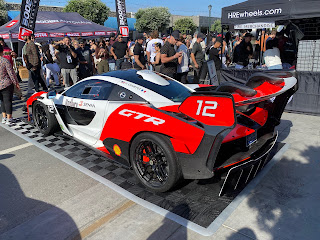The Sterrato is one of the coolest and most fascinating versions of the Lamborghini Huracan. It is also one of two fairly recent factory-built off-road sports cars/supercars, which are considered to be a rare and unique breed of vehicle, with the other one being the Porsche 911 Dakar. Lamborghini added the rugged Sterrato to the Huracan lineup for 2023, which will be the last version of the Huracan planned by Lamborghini. The Huracan's 5.2-liter V10 has been de-tuned to 602 horsepower from 630 in other Huracan models, while torque figures remain the same at 413 pound-feet. This is due to the Huracan's side-mounted air intakes being covered up to prevent dirt and dust from getting into the engine. The Sterrato launches from zero to 60 mph in 3.3 seconds and has its top speed limited to 160 mph since it is tuned for off-roading. Paired to its V10 is a seven-speed dual-clutch automatic gearbox sending power to all four wheels. In addition, the Sterrato contains a taller ride height of 6.4 inches, 1.7 inches over the not-as-rugged Huracan models, along with a central air intake on the back of the roof, a Rally mode, carbon-fiber wheel arch extensions, all-terrain tires, no active rear steering, front rally lights, underbody protection, and other features intended especially for traversing through dusty and sandy conditions. Its roof rails can support some overhead cargo but nothing too huge like a tent.
Inside, the Sterrato's interior is practically the same as other versions of the Huracan, however the Sterrato's infotainment system adds off-road-focused features such as an inclinometer, a pitch and roll indicator, a compass, and a steering angle repeater. The Sterrato will also receive an updated data recording system as well. Lamborghini will produce only 900 total units of the Huracan Sterrato for all markets, with pricing starting at $278,972 a pop. Its production run will last until Lamborghini ultimately ends production of all Huracan models and announce the Huracan's successor. The 2023 Exotics on Broadway Show in Monterey marked the fist time I ever saw a Huracan Sterrato in person. This show also featured a handful of other Huracan models as well, namely the base version, Evo, Performante, STO, and a street-legal Super Trofeo Evo, but those will be shown on this site at a later date. As of now, the only Huracan variant I have yet to see in person is the Technica, which is one of the more recent Huracan models and slots in between the Evo and STO in the Huracan hierarchy. Its off-road aspects may hinder its overall performance compared to other Lamborghinis, but the Huracan Sterrato is just plain awesome. Besides legitimate rally racers, very few vehicles like the Sterrato exist with its level of prowess and go-anywhere capability.
You can further support my blogs by checking out my merch (sample pictured below): CPF Store














































